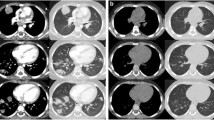Abstract
Invasive fungal disease represents one of the severe complications in haematopoietic stem cell transplant recipients. We describe a case of a patient treated for relapse of chronic lymphoblastic leukaemia 6 years after HSCT. The patient was treated for invasive pulmonary aspergillosis but died 3 months later from multiple organ failures consisting of haemorrhagic necrotizing fungal pneumonia, refractory chronic hepatic graft versus host disease and cytomegalovirus hepatitis. Autopsy samples revealed histopathological evidence of fungal hyphae and an unusual Aspergillus nidulans-like species was isolated in pure culture. More precise identification was achieved by using scanning electron microscopy of ascospores and sequencing of calmodulin gene, and the isolate was subsequently re-identified as A. sublatus (section Nidulantes) and showed good in vitro susceptibility against all classes of antifungals. Commonly used ITS rDNA region and β-tubulin gene fail to discriminate A. sublatus from related pathogenic species, especially A. quadrilineatus and A. nidulans. Although this is the first case of proven IPA attributed to A. sublatus, we demonstrated that at least some previously reported infections due to A. quadrilineatus were probably caused by this cryptic species.


Similar content being viewed by others
References
Corzo-Leon DE, Satlin MJ, Soave R, Shore TB, Schuetz AN, Jacobs SE, et al. Epidemiology and outcomes of invasive fungal infections in allogeneic haematopoietic stem cell transplant recipients in the era of antifungal prophylaxis: a single-centre study with focus on emerging pathogens. Mycoses. 2015;58(6):325–36.
Harrison N, Mitterbauer M, Tobudic S, Kalhs P, Rabitsch W, Greinix H, et al. Incidence and characteristics of invasive fungal diseases in allogeneic hematopoietic stem cell transplant recipients: a retrospective cohort study. BMC Infect Dis. 2015;15:584.
de Fontbrune FS, Denis B, Meunier M, Garcia-Hermoso D, Bretagne S, Alanio A. Iterative breakthrough invasive aspergillosis due to TR(34)/L98H azole-resistant Aspergillus fumigatus and Emericella sublata in a single hematopoietic stem cell transplant patient. Transpl Infect Dis. 2014;16(4):687–91.
Hubka V, Lyskova P, Frisvad JC, Peterson SW, Skorepova M, Kolarik M. Aspergillus pragensis sp. nov. discovered during molecular reidentification of clinical isolates belonging to Aspergillus section Candidi. Med Mycol. 2014;52(6):565–76.
Junghanss C, Marr KA, Carter RA, Sandmaier BM, Maris MB, Maloney DG, et al. Incidence and outcome of bacterial and fungal infections following nonmyeloablative compared with myeloablative allogeneic hematopoietic stem cell transplantation: a matched control study. Biol Blood Marrow Transplant. 2002;8(9):512–20.
Tissot F, Agrawal S, Pagano L, Petrikkos G, Groll AH, Skiada A, et al. ECIL-6 guidelines for the treatment of invasive candidiasis, aspergillosis and mucormycosis in leukemia and hematopoietic stem cell transplant patients. Haematologica. 2017;102(3):433–44.
Luong ML, Al-Dabbagh M, Groll AH, Racil Z, Nannya Y, Mitsani D, et al. Utility of voriconazole therapeutic drug monitoring: a meta-analysis. J Antimicrob Chemother. 2016;71(7):1786–99.
Samson R, Visagie C, Houbraken J, Hong S, Hubka V, Klaassen C, et al. Phylogeny, identification and nomenclature of the genus Aspergillus. Stud Mycol. 2014;78:141–73.
Gautier M, Normand AC, Ranque S. Previously unknown species of Aspergillus. Clin Microbiol Infect. 2016;22(8):662–9.
Hubka V, Novakova A, Peterson SW, Frisvad JC, Sklenar F, Matsuzawa T, et al. A reappraisal of Aspergillus section Nidulantes with descriptions of two new sterigmatocystin-producing species. Plant Syst Evol. 2016;2016(302):1267–99.
Balajee SA, Houbraken J, Verweij PE, Hong SB, Yaghuchi T, Varga J, et al. Aspergillus species identification in the clinical setting. Stud Mycol. 2007;59:39–46.
Chen AJ, Frisvad JC, Sun BD, Varga J, Kocsube S, Dijksterhuis J, et al. Aspergillus section Nidulantes (formerly Emericella): polyphasic taxonomy, chemistry and biology. Stud Mycol. 2016;84:1–118.
Verweij PE, Varga J, Houbraken J, Rijs AJ, Verduynlunel FM, Blijlevens NM, et al. Emericella quadrilineata as cause of invasive aspergillosis. Emerg Infect Dis. 2008;14(4):566–72.
Hubka V, Dudová Z, Kubátová A, Frisvad J, Yaguchi T, Horie Y, et al. Taxonomic novelties in Aspergillus section Fumigati: A. tasmanicus sp. nov., induction of sexual state in A. turcosus and overview of related species. Plant Syst Evol. 2017;303:787–806.
Acknowledgements
We want to acknowledge Dana Michalska for the performance of culture and molecular-biology-based methods, Milena Antuskova for the sequence analysis, Eva Klapkova for the HPLC performance, Alena Kubatova for providing SEM photos and Zeljko Jurjevic for providing environmental isolates of A. sublatus.
Author’s Contribution
Vanda Chrenkova—microbiological examination of autopsy samples, main text preparation, corresponding author Vit Hubka—phylogenetic analysis, identification of Aspergillus, methods and figure, discussion. Petr Cetkovsky—clinical case report. Michal Kouba—clinical case report, radiology findings. Barbora Weinbergerova—clinical data collection. Pavlina Lyskova—experimental work. Ludmila Hornofova—autopsy and histopathological examination, photography. Petr Hubacek—clinical case report, supervisor, main text revision.
Funding
This research was supported by the project of Ministry of Health of the Czech Republic for conceptual development of research organization 00064203 (University Hospital Motol, Prague, Czech Republic), by the project BIOCEV (CZ.1.05/1.1.00/02.0109) provided by the Ministry of Education, Youth and Sports of CR and ERDF and by FIND (Fungal InfectioN Database)—the project of the CzEch Leukemia study group for Life (CELL). Vit Hubka is grateful for support from Czechoslovak Microscopy Society (CSMS scholarship 2016).
Author information
Authors and Affiliations
Corresponding author
Ethics declarations
Conflicts of interest
The authors declare that they have no conflict of interest.
Rights and permissions
About this article
Cite this article
Chrenkova, V., Hubka, V., Cetkovsky, P. et al. Proven Invasive Pulmonary Aspergillosis in Stem Cell Transplant Recipient Due to Aspergillus sublatus, a Cryptic Species of A. nidulans . Mycopathologia 183, 423–429 (2018). https://doi.org/10.1007/s11046-017-0223-8
Received:
Accepted:
Published:
Issue Date:
DOI: https://doi.org/10.1007/s11046-017-0223-8




